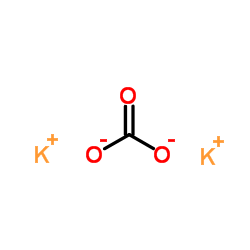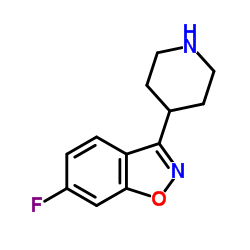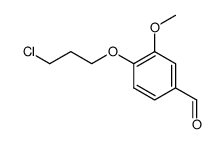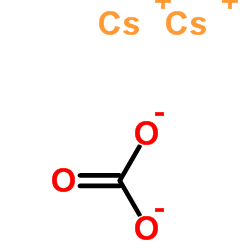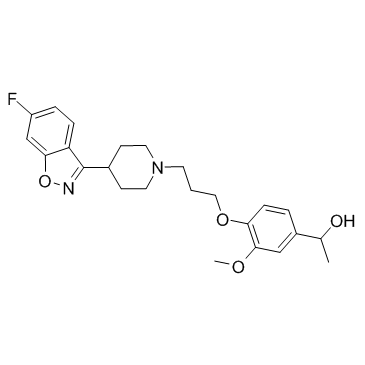133454-47-4
| Name | iloperidone |
|---|---|
| Synonyms |
1-(4-{3-[4-(6-Fluoro-1,2-benzoxazol-3-yl)-1-piperidinyl]propoxy}-3-methoxyphenyl)ethanone
1-[4-[3-[4-(6-fluoro-1,2-benzoxazol-3-yl)piperidin-1-yl]propoxy]-3-methoxyphenyl]ethanone Zomaril iloperidone 1-(4-(3-(4-(6-Fluoro-1,2-benzisoxazol-3-yl)-1-piperidinyl)propoxy)-3-methoxyphenyl)ethanone Fanapta Ethanone, 1-[4-[3-[4-(6-fluoro-1,2-benzisoxazol-3-yl)-1-piperidinyl]propoxy]-3-methoxyphenyl]- 1-(4-{3-[4-(6-Fluoro-1,2-benzoxazol-3-yl)piperidin-1-yl]propoxy}-3-methoxyphenyl)ethanone Fanapt |
| Description | Iloperidone(HP 873) is a D2/5-HT2 receptor antagonist, which is an atypical antipsychotic for the treatment of schizophrenia symptoms.IC50 value:Target: 5-HT receptor; D2 receptorIloperidone (HP 873) is a compound currently in clinical trials for the treatment of schizophrenia. Iloperidone displays affinity for dopamine D2 receptors and for 5-HT2A receptors and has a variety of in vivo activities suggestive of an atypical antipsychotic. Iloperidone displayed higher affinity for the dopamine D3 receptor (Ki = 7.1 nM) than for the dopamine D4 receptor (Ki = 25 nM). Iloperidone displayed high affinity for the 5-HT6 and 5-HT7 receptors (Ki = 42.7 and 21.6 nM, respectively), and was found to have higher affinity for the 5-HT2A (Ki = 5.6 nM) than for the 5-HT2C receptor (Ki = 42.8 nM) [1]. Iloperidone was eliminated slowly, with a mean t1/2 of 13.5 to 14.0 hours. Coadministration with food did not significantly affect AUC, tmax, or Cmax. These results indicate that the rate of iloperidone's absorption is decreased, but the overall bioavailability is unchanged, when the drug is taken with food. Orthostatic hypotension, dizziness, and somnolence were the most commonly reported adverse events [2]. Iloperidone pharmacokinetics and pharmacodynamics are presented herein, together with an evaluation of clinical safety and efficacy results [3].Clinical indications: Post traumatic stress disorder; Schizophrenia Toxicity: Commonly observed adverse reactions (incidence ≥5% and two-fold greater than placebo) were: dizziness, dry mouth, fatigue, nasal congestion, orthostatic hypotension, somnolence, tachycardia, and weight increased. |
|---|---|
| Related Catalog | |
| References |
| Density | 1.2±0.1 g/cm3 |
|---|---|
| Boiling Point | 593.7±50.0 °C at 760 mmHg |
| Melting Point | 118-120°C |
| Molecular Formula | C24H27FN2O4 |
| Molecular Weight | 426.481 |
| Flash Point | 312.8±30.1 °C |
| Exact Mass | 426.195496 |
| PSA | 64.80000 |
| LogP | 3.81 |
| Appearance | white to beige |
| Vapour Pressure | 0.0±1.7 mmHg at 25°C |
| Index of Refraction | 1.570 |
| Storage condition | -20°C Freezer, Under Inert Atmosphere |
| Water Solubility | DMSO: soluble5mg/mL, clear |
| Symbol |



GHS02, GHS06, GHS08 |
|---|---|
| Signal Word | Danger |
| Hazard Statements | H225-H301 + H311 + H331-H370 |
| Precautionary Statements | P210-P260-P280-P301 + P310-P311 |
| Hazard Codes | F,T |
| Risk Phrases | 11-23/24/25-39/23/24/25 |
| Safety Phrases | 16-36/37-45 |
| RIDADR | UN2811 - class 6.1 - PG 3 - EHS - Toxic solids, organic, n.o.s., HI: all |
| RTECS | KM5777850 |
| HS Code | 2934999090 |
| Precursor 10 | |
|---|---|
| DownStream 1 | |
| HS Code | 2934999090 |
|---|---|
| Summary | 2934999090. other heterocyclic compounds. VAT:17.0%. Tax rebate rate:13.0%. . MFN tariff:6.5%. General tariff:20.0% |

![3-[1-(3-chloropropyl)-4-piperidinyl]-6-fluoro-1,2-benzisoxazole structure](https://image.chemsrc.com/caspic/160/329977-73-3.png)
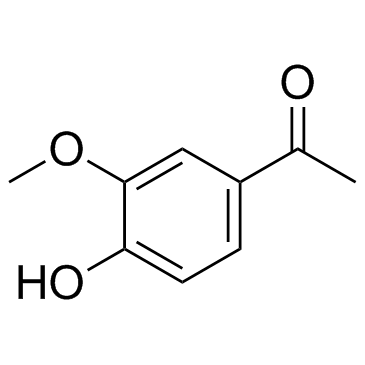


![1-[4-(3-Chloropropoxy)-3-methoxyphenyl]ethanone structure](https://image.chemsrc.com/caspic/472/58113-30-7.png)

